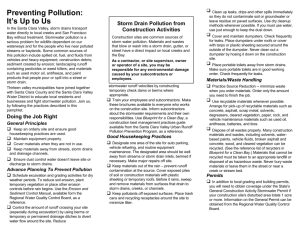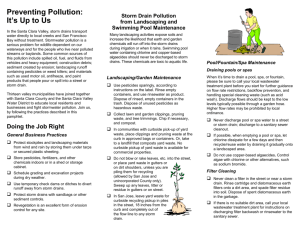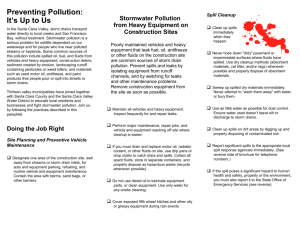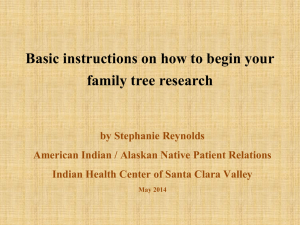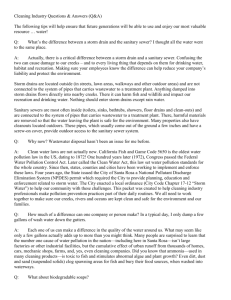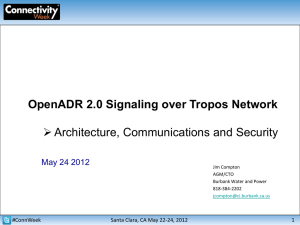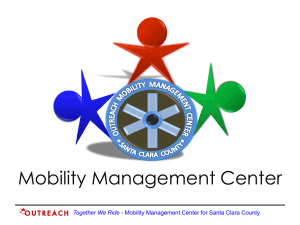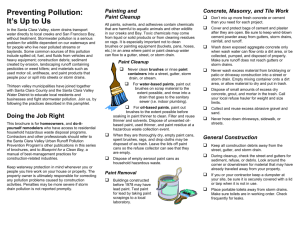Concrete - Contra Costa Clean Water Program
advertisement
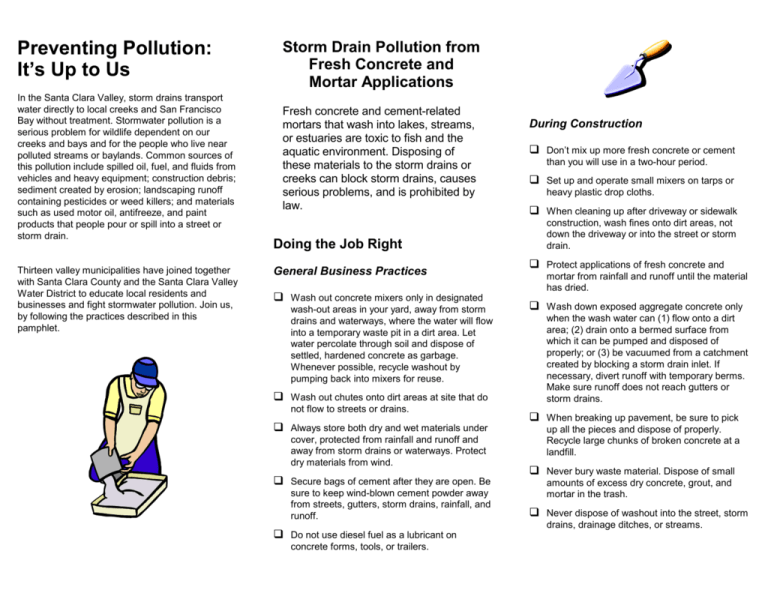
Preventing Pollution: It’s Up to Us In the Santa Clara Valley, storm drains transport water directly to local creeks and San Francisco Bay without treatment. Stormwater pollution is a serious problem for wildlife dependent on our creeks and bays and for the people who live near polluted streams or baylands. Common sources of this pollution include spilled oil, fuel, and fluids from vehicles and heavy equipment; construction debris; sediment created by erosion; landscaping runoff containing pesticides or weed killers; and materials such as used motor oil, antifreeze, and paint products that people pour or spill into a street or storm drain. Thirteen valley municipalities have joined together with Santa Clara County and the Santa Clara Valley Water District to educate local residents and businesses and fight stormwater pollution. Join us, by following the practices described in this pamphlet. Storm Drain Pollution from Fresh Concrete and Mortar Applications Fresh concrete and cement-related mortars that wash into lakes, streams, or estuaries are toxic to fish and the aquatic environment. Disposing of these materials to the storm drains or creeks can block storm drains, causes serious problems, and is prohibited by law. Doing the Job Right General Business Practices Wash out concrete mixers only in designated wash-out areas in your yard, away from storm drains and waterways, where the water will flow into a temporary waste pit in a dirt area. Let water percolate through soil and dispose of settled, hardened concrete as garbage. Whenever possible, recycle washout by pumping back into mixers for reuse. Wash out chutes onto dirt areas at site that do not flow to streets or drains. Always store both dry and wet materials under cover, protected from rainfall and runoff and away from storm drains or waterways. Protect dry materials from wind. Secure bags of cement after they are open. Be sure to keep wind-blown cement powder away from streets, gutters, storm drains, rainfall, and runoff. Do not use diesel fuel as a lubricant on concrete forms, tools, or trailers. During Construction Don’t mix up more fresh concrete or cement than you will use in a two-hour period. Set up and operate small mixers on tarps or heavy plastic drop cloths. When cleaning up after driveway or sidewalk construction, wash fines onto dirt areas, not down the driveway or into the street or storm drain. Protect applications of fresh concrete and mortar from rainfall and runoff until the material has dried. Wash down exposed aggregate concrete only when the wash water can (1) flow onto a dirt area; (2) drain onto a bermed surface from which it can be pumped and disposed of properly; or (3) be vacuumed from a catchment created by blocking a storm drain inlet. If necessary, divert runoff with temporary berms. Make sure runoff does not reach gutters or storm drains. When breaking up pavement, be sure to pick up all the pieces and dispose of properly. Recycle large chunks of broken concrete at a landfill. Never bury waste material. Dispose of small amounts of excess dry concrete, grout, and mortar in the trash. Never dispose of washout into the street, storm drains, drainage ditches, or streams. Small Business Hazardous Waste Disposal Program Spill Response Agencies: Businesses that generate less than 27 gallons or 220 pounds of hazardous waste per month are eligible to use Santa Clara County’s Small Business Hazardous Waste Disposal Program. Call (408) 299-7300 for a quote, more information or guidance on disposal. 2. In the City of Palo Alto, call (650) 329-2413. Palo Alto operates a similar program, with monthly collection, for small businesses. Call the City of Palo Alto, (650) 496-6980, or Greenfield Services Corporation, 1-800-433-5060 for information or to schedule an appointment. This brochure is one in a series of pamphlets describing storm drain pollution prevention measures for specific types of construction industry activities. Other pamphlets include: Home Repair and Remodeling General Construction and Site Supervision Landscaping, Gardening, and Pool Maintenance Painting and Application of Solvents and Adhesives 1. In the City of Santa Clara, call (408) 984-3080. 3. In the City of San Jose, dial 9-1-1 if hazardous materials enter the storm drain system. For non-hazardous spills, call (408) 945-3000. 4. In other cities, DIAL 9-1-1 5. State Office of Emergency Services Warning Center (24 hours). . . . . . . . . . .1-800-852-7550 Local Pollution Control Agencies County of Santa Clara Pollution Prevention Program. . . . .(408) 441-1195 County of Santa Clara Integrated Waste Management Program. . . . . . . . . . (408) 441-1198 County of Santa Clara District Attorney Environmental Crimes Hotline. . . . (408) 299-TIPS Santa Clara County Recycling Hotline. . . . . . . . . . . . . .1-800-533-8414 Santa Clara Valley Water District. . . . . . . . . . . . . . . . . . . . . . (408) 265-2600 Santa Clara Valley Water District Pollution Hotline. . . . . . . . .1-888-510-5151 Heavy Equipment Operation For additional brochures, call 1-800-794-2482 Sunnyvale Water Pollution Control Plant Serving Sunnyvale. . . . . . .. . (408) 730-7270 Earth Moving Activities and Dewatering Activities Best Management Practices for the Construction Industry 6. Santa Clara County Environmental Health Services. . . . . . . . . . . . . . . . . .(408) 299-6930 San Jose/Santa Clara Water Pollution Control Plant. . . . . . .. . . .(408) 945-3000 Serving Campbell, Cupertino, Los Gatos, Milpitas, Monte Sereno, San Jose, Santa Clara, Saratoga Roadwork and Paving Fresh Concrete and Mortar Application Regional Water Quality Control Plant. . . . . . . . . . . . . . . . . .(650) 329-2598 Serving East Palo Alto Sanitary District, Los Altos, Los Altos Hills, Mountain View, Palo Alto, Stanford Regional Water Quality Control Board San Francisco Bay Region. . . . . . . (510) 622-2300 June 2001 Who should use this brochure? Masons and bricklayers Sidewalk construction crews Patio construction workers Construction inspectors General contractors Home builders Developers Concrete delivery/pumping workers
